Persuasive Argument and Fallacies
VerifiedAdded on 2022/12/18
|7
|1680
|94
AI Summary
This essay discusses the use of fallacies in persuasive arguments and how they can mislead and manipulate the audience. It explores various factors and strategies used to persuade arguments through fallacies.
Contribute Materials
Your contribution can guide someone’s learning journey. Share your
documents today.
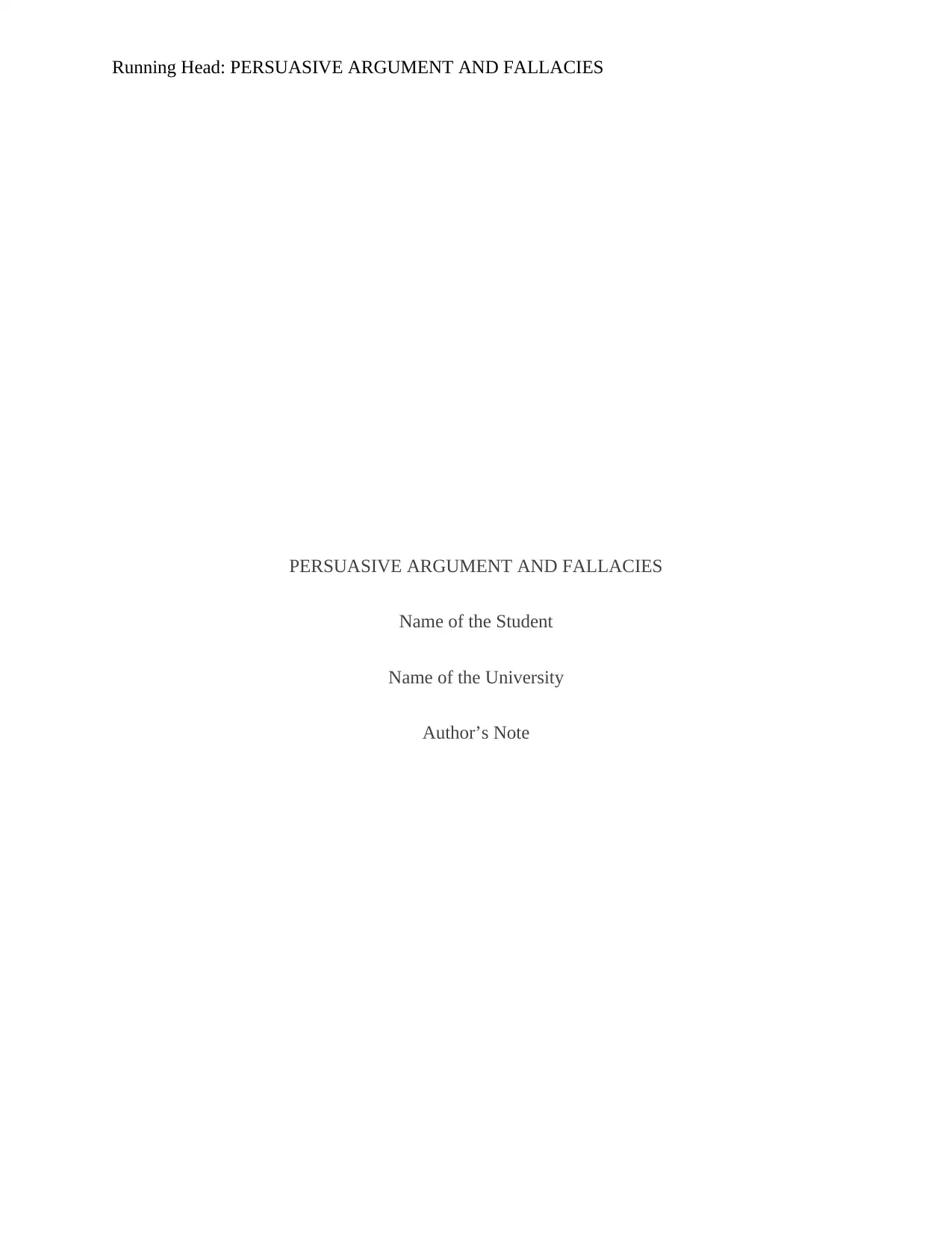
Running Head: PERSUASIVE ARGUMENT AND FALLACIES
PERSUASIVE ARGUMENT AND FALLACIES
Name of the Student
Name of the University
Author’s Note
PERSUASIVE ARGUMENT AND FALLACIES
Name of the Student
Name of the University
Author’s Note
Secure Best Marks with AI Grader
Need help grading? Try our AI Grader for instant feedback on your assignments.
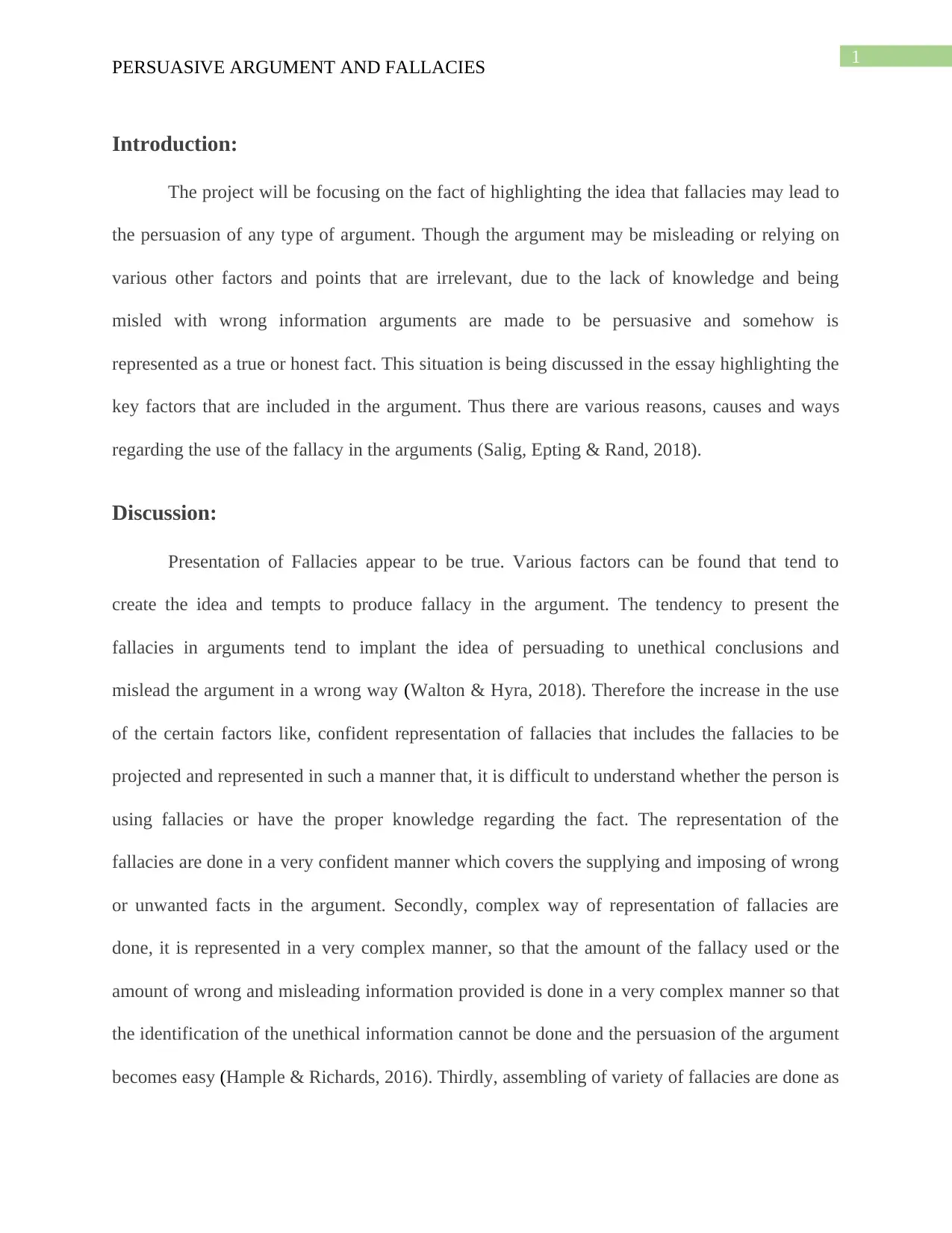
1
PERSUASIVE ARGUMENT AND FALLACIES
Introduction:
The project will be focusing on the fact of highlighting the idea that fallacies may lead to
the persuasion of any type of argument. Though the argument may be misleading or relying on
various other factors and points that are irrelevant, due to the lack of knowledge and being
misled with wrong information arguments are made to be persuasive and somehow is
represented as a true or honest fact. This situation is being discussed in the essay highlighting the
key factors that are included in the argument. Thus there are various reasons, causes and ways
regarding the use of the fallacy in the arguments (Salig, Epting & Rand, 2018).
Discussion:
Presentation of Fallacies appear to be true. Various factors can be found that tend to
create the idea and tempts to produce fallacy in the argument. The tendency to present the
fallacies in arguments tend to implant the idea of persuading to unethical conclusions and
mislead the argument in a wrong way (Walton & Hyra, 2018). Therefore the increase in the use
of the certain factors like, confident representation of fallacies that includes the fallacies to be
projected and represented in such a manner that, it is difficult to understand whether the person is
using fallacies or have the proper knowledge regarding the fact. The representation of the
fallacies are done in a very confident manner which covers the supplying and imposing of wrong
or unwanted facts in the argument. Secondly, complex way of representation of fallacies are
done, it is represented in a very complex manner, so that the amount of the fallacy used or the
amount of wrong and misleading information provided is done in a very complex manner so that
the identification of the unethical information cannot be done and the persuasion of the argument
becomes easy (Hample & Richards, 2016). Thirdly, assembling of variety of fallacies are done as
PERSUASIVE ARGUMENT AND FALLACIES
Introduction:
The project will be focusing on the fact of highlighting the idea that fallacies may lead to
the persuasion of any type of argument. Though the argument may be misleading or relying on
various other factors and points that are irrelevant, due to the lack of knowledge and being
misled with wrong information arguments are made to be persuasive and somehow is
represented as a true or honest fact. This situation is being discussed in the essay highlighting the
key factors that are included in the argument. Thus there are various reasons, causes and ways
regarding the use of the fallacy in the arguments (Salig, Epting & Rand, 2018).
Discussion:
Presentation of Fallacies appear to be true. Various factors can be found that tend to
create the idea and tempts to produce fallacy in the argument. The tendency to present the
fallacies in arguments tend to implant the idea of persuading to unethical conclusions and
mislead the argument in a wrong way (Walton & Hyra, 2018). Therefore the increase in the use
of the certain factors like, confident representation of fallacies that includes the fallacies to be
projected and represented in such a manner that, it is difficult to understand whether the person is
using fallacies or have the proper knowledge regarding the fact. The representation of the
fallacies are done in a very confident manner which covers the supplying and imposing of wrong
or unwanted facts in the argument. Secondly, complex way of representation of fallacies are
done, it is represented in a very complex manner, so that the amount of the fallacy used or the
amount of wrong and misleading information provided is done in a very complex manner so that
the identification of the unethical information cannot be done and the persuasion of the argument
becomes easy (Hample & Richards, 2016). Thirdly, assembling of variety of fallacies are done as
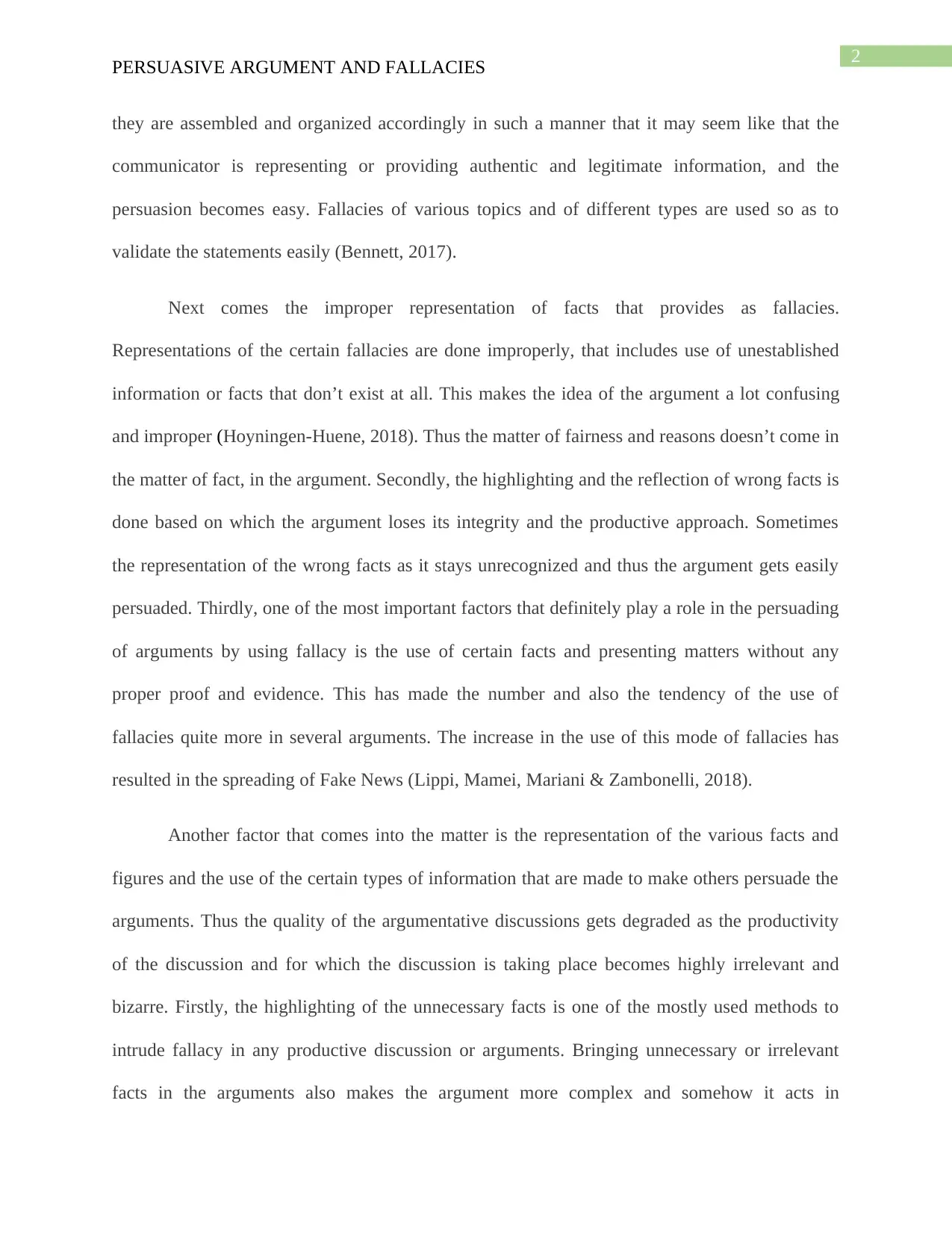
2
PERSUASIVE ARGUMENT AND FALLACIES
they are assembled and organized accordingly in such a manner that it may seem like that the
communicator is representing or providing authentic and legitimate information, and the
persuasion becomes easy. Fallacies of various topics and of different types are used so as to
validate the statements easily (Bennett, 2017).
Next comes the improper representation of facts that provides as fallacies.
Representations of the certain fallacies are done improperly, that includes use of unestablished
information or facts that don’t exist at all. This makes the idea of the argument a lot confusing
and improper (Hoyningen-Huene, 2018). Thus the matter of fairness and reasons doesn’t come in
the matter of fact, in the argument. Secondly, the highlighting and the reflection of wrong facts is
done based on which the argument loses its integrity and the productive approach. Sometimes
the representation of the wrong facts as it stays unrecognized and thus the argument gets easily
persuaded. Thirdly, one of the most important factors that definitely play a role in the persuading
of arguments by using fallacy is the use of certain facts and presenting matters without any
proper proof and evidence. This has made the number and also the tendency of the use of
fallacies quite more in several arguments. The increase in the use of this mode of fallacies has
resulted in the spreading of Fake News (Lippi, Mamei, Mariani & Zambonelli, 2018).
Another factor that comes into the matter is the representation of the various facts and
figures and the use of the certain types of information that are made to make others persuade the
arguments. Thus the quality of the argumentative discussions gets degraded as the productivity
of the discussion and for which the discussion is taking place becomes highly irrelevant and
bizarre. Firstly, the highlighting of the unnecessary facts is one of the mostly used methods to
intrude fallacy in any productive discussion or arguments. Bringing unnecessary or irrelevant
facts in the arguments also makes the argument more complex and somehow it acts in
PERSUASIVE ARGUMENT AND FALLACIES
they are assembled and organized accordingly in such a manner that it may seem like that the
communicator is representing or providing authentic and legitimate information, and the
persuasion becomes easy. Fallacies of various topics and of different types are used so as to
validate the statements easily (Bennett, 2017).
Next comes the improper representation of facts that provides as fallacies.
Representations of the certain fallacies are done improperly, that includes use of unestablished
information or facts that don’t exist at all. This makes the idea of the argument a lot confusing
and improper (Hoyningen-Huene, 2018). Thus the matter of fairness and reasons doesn’t come in
the matter of fact, in the argument. Secondly, the highlighting and the reflection of wrong facts is
done based on which the argument loses its integrity and the productive approach. Sometimes
the representation of the wrong facts as it stays unrecognized and thus the argument gets easily
persuaded. Thirdly, one of the most important factors that definitely play a role in the persuading
of arguments by using fallacy is the use of certain facts and presenting matters without any
proper proof and evidence. This has made the number and also the tendency of the use of
fallacies quite more in several arguments. The increase in the use of this mode of fallacies has
resulted in the spreading of Fake News (Lippi, Mamei, Mariani & Zambonelli, 2018).
Another factor that comes into the matter is the representation of the various facts and
figures and the use of the certain types of information that are made to make others persuade the
arguments. Thus the quality of the argumentative discussions gets degraded as the productivity
of the discussion and for which the discussion is taking place becomes highly irrelevant and
bizarre. Firstly, the highlighting of the unnecessary facts is one of the mostly used methods to
intrude fallacy in any productive discussion or arguments. Bringing unnecessary or irrelevant
facts in the arguments also makes the argument more complex and somehow it acts in
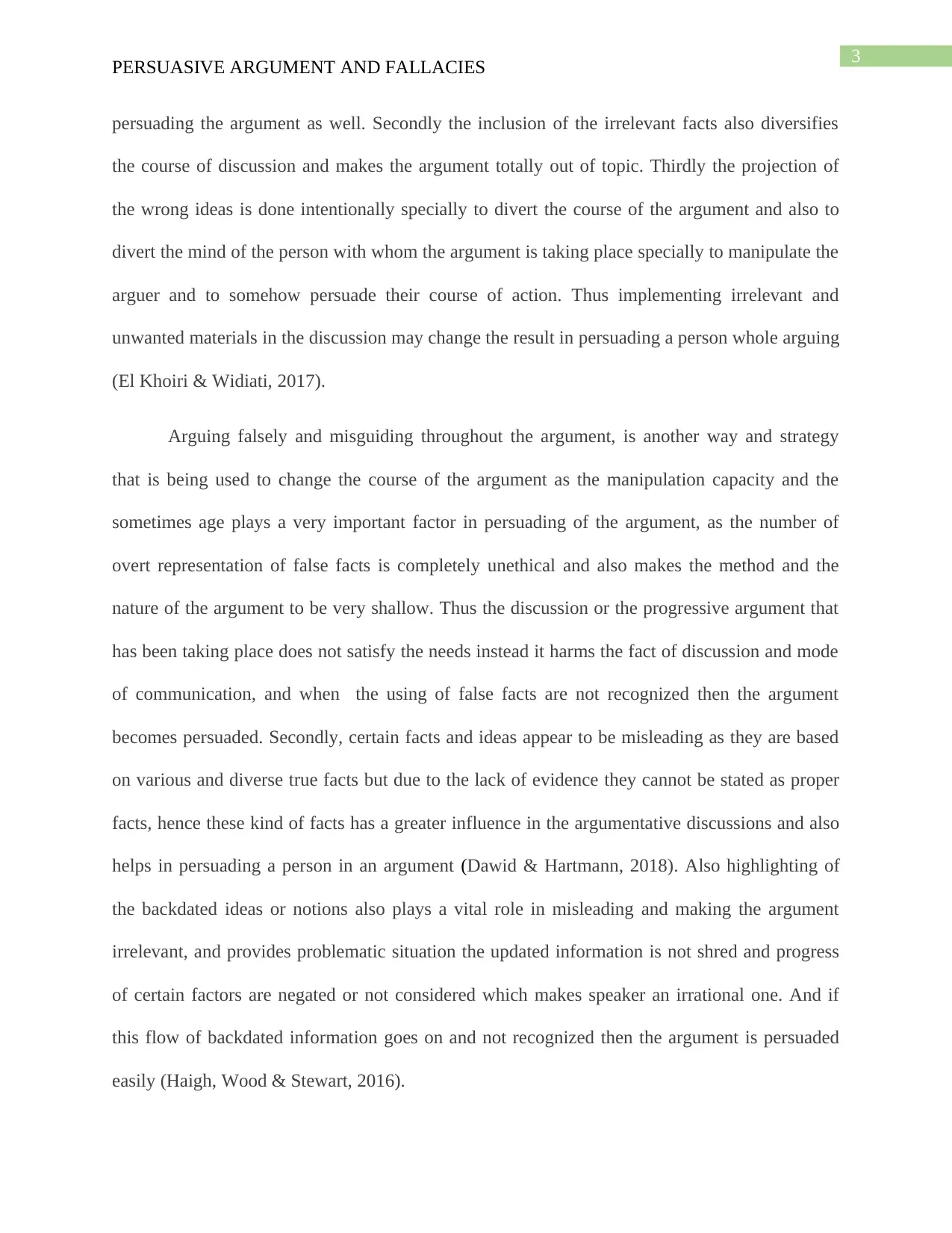
3
PERSUASIVE ARGUMENT AND FALLACIES
persuading the argument as well. Secondly the inclusion of the irrelevant facts also diversifies
the course of discussion and makes the argument totally out of topic. Thirdly the projection of
the wrong ideas is done intentionally specially to divert the course of the argument and also to
divert the mind of the person with whom the argument is taking place specially to manipulate the
arguer and to somehow persuade their course of action. Thus implementing irrelevant and
unwanted materials in the discussion may change the result in persuading a person whole arguing
(El Khoiri & Widiati, 2017).
Arguing falsely and misguiding throughout the argument, is another way and strategy
that is being used to change the course of the argument as the manipulation capacity and the
sometimes age plays a very important factor in persuading of the argument, as the number of
overt representation of false facts is completely unethical and also makes the method and the
nature of the argument to be very shallow. Thus the discussion or the progressive argument that
has been taking place does not satisfy the needs instead it harms the fact of discussion and mode
of communication, and when the using of false facts are not recognized then the argument
becomes persuaded. Secondly, certain facts and ideas appear to be misleading as they are based
on various and diverse true facts but due to the lack of evidence they cannot be stated as proper
facts, hence these kind of facts has a greater influence in the argumentative discussions and also
helps in persuading a person in an argument (Dawid & Hartmann, 2018). Also highlighting of
the backdated ideas or notions also plays a vital role in misleading and making the argument
irrelevant, and provides problematic situation the updated information is not shred and progress
of certain factors are negated or not considered which makes speaker an irrational one. And if
this flow of backdated information goes on and not recognized then the argument is persuaded
easily (Haigh, Wood & Stewart, 2016).
PERSUASIVE ARGUMENT AND FALLACIES
persuading the argument as well. Secondly the inclusion of the irrelevant facts also diversifies
the course of discussion and makes the argument totally out of topic. Thirdly the projection of
the wrong ideas is done intentionally specially to divert the course of the argument and also to
divert the mind of the person with whom the argument is taking place specially to manipulate the
arguer and to somehow persuade their course of action. Thus implementing irrelevant and
unwanted materials in the discussion may change the result in persuading a person whole arguing
(El Khoiri & Widiati, 2017).
Arguing falsely and misguiding throughout the argument, is another way and strategy
that is being used to change the course of the argument as the manipulation capacity and the
sometimes age plays a very important factor in persuading of the argument, as the number of
overt representation of false facts is completely unethical and also makes the method and the
nature of the argument to be very shallow. Thus the discussion or the progressive argument that
has been taking place does not satisfy the needs instead it harms the fact of discussion and mode
of communication, and when the using of false facts are not recognized then the argument
becomes persuaded. Secondly, certain facts and ideas appear to be misleading as they are based
on various and diverse true facts but due to the lack of evidence they cannot be stated as proper
facts, hence these kind of facts has a greater influence in the argumentative discussions and also
helps in persuading a person in an argument (Dawid & Hartmann, 2018). Also highlighting of
the backdated ideas or notions also plays a vital role in misleading and making the argument
irrelevant, and provides problematic situation the updated information is not shred and progress
of certain factors are negated or not considered which makes speaker an irrational one. And if
this flow of backdated information goes on and not recognized then the argument is persuaded
easily (Haigh, Wood & Stewart, 2016).
Secure Best Marks with AI Grader
Need help grading? Try our AI Grader for instant feedback on your assignments.
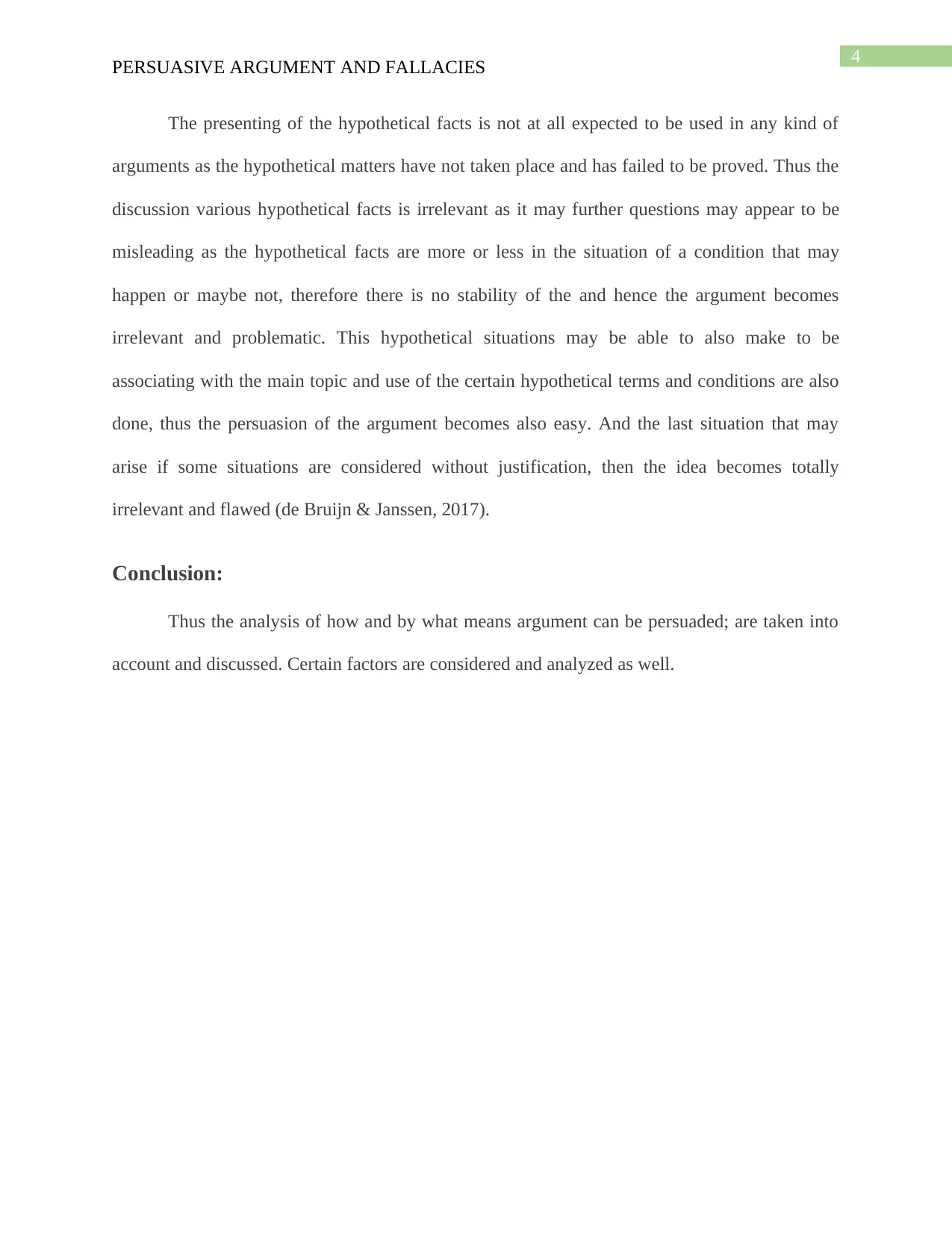
4
PERSUASIVE ARGUMENT AND FALLACIES
The presenting of the hypothetical facts is not at all expected to be used in any kind of
arguments as the hypothetical matters have not taken place and has failed to be proved. Thus the
discussion various hypothetical facts is irrelevant as it may further questions may appear to be
misleading as the hypothetical facts are more or less in the situation of a condition that may
happen or maybe not, therefore there is no stability of the and hence the argument becomes
irrelevant and problematic. This hypothetical situations may be able to also make to be
associating with the main topic and use of the certain hypothetical terms and conditions are also
done, thus the persuasion of the argument becomes also easy. And the last situation that may
arise if some situations are considered without justification, then the idea becomes totally
irrelevant and flawed (de Bruijn & Janssen, 2017).
Conclusion:
Thus the analysis of how and by what means argument can be persuaded; are taken into
account and discussed. Certain factors are considered and analyzed as well.
PERSUASIVE ARGUMENT AND FALLACIES
The presenting of the hypothetical facts is not at all expected to be used in any kind of
arguments as the hypothetical matters have not taken place and has failed to be proved. Thus the
discussion various hypothetical facts is irrelevant as it may further questions may appear to be
misleading as the hypothetical facts are more or less in the situation of a condition that may
happen or maybe not, therefore there is no stability of the and hence the argument becomes
irrelevant and problematic. This hypothetical situations may be able to also make to be
associating with the main topic and use of the certain hypothetical terms and conditions are also
done, thus the persuasion of the argument becomes also easy. And the last situation that may
arise if some situations are considered without justification, then the idea becomes totally
irrelevant and flawed (de Bruijn & Janssen, 2017).
Conclusion:
Thus the analysis of how and by what means argument can be persuaded; are taken into
account and discussed. Certain factors are considered and analyzed as well.
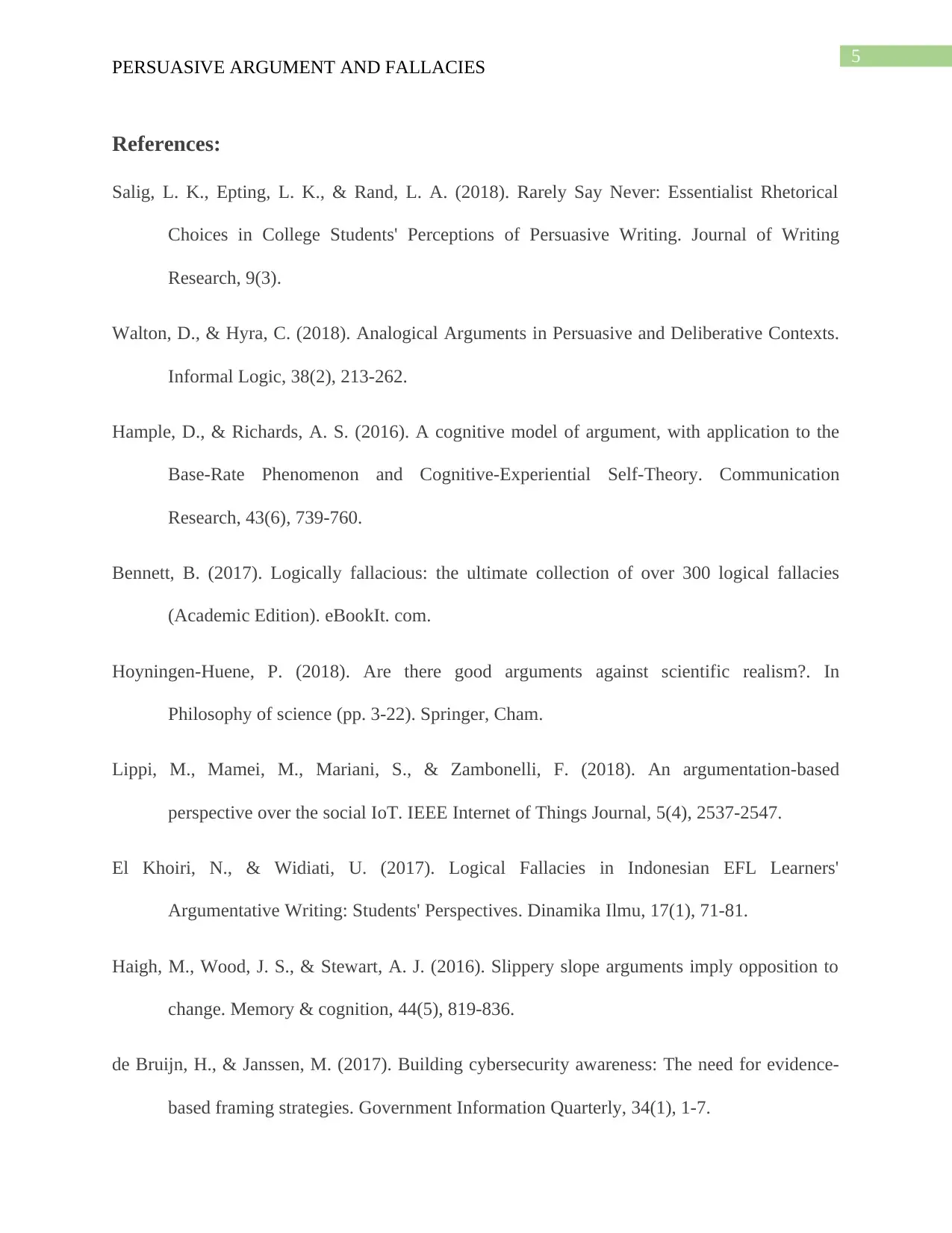
5
PERSUASIVE ARGUMENT AND FALLACIES
References:
Salig, L. K., Epting, L. K., & Rand, L. A. (2018). Rarely Say Never: Essentialist Rhetorical
Choices in College Students' Perceptions of Persuasive Writing. Journal of Writing
Research, 9(3).
Walton, D., & Hyra, C. (2018). Analogical Arguments in Persuasive and Deliberative Contexts.
Informal Logic, 38(2), 213-262.
Hample, D., & Richards, A. S. (2016). A cognitive model of argument, with application to the
Base-Rate Phenomenon and Cognitive-Experiential Self-Theory. Communication
Research, 43(6), 739-760.
Bennett, B. (2017). Logically fallacious: the ultimate collection of over 300 logical fallacies
(Academic Edition). eBookIt. com.
Hoyningen-Huene, P. (2018). Are there good arguments against scientific realism?. In
Philosophy of science (pp. 3-22). Springer, Cham.
Lippi, M., Mamei, M., Mariani, S., & Zambonelli, F. (2018). An argumentation-based
perspective over the social IoT. IEEE Internet of Things Journal, 5(4), 2537-2547.
El Khoiri, N., & Widiati, U. (2017). Logical Fallacies in Indonesian EFL Learners'
Argumentative Writing: Students' Perspectives. Dinamika Ilmu, 17(1), 71-81.
Haigh, M., Wood, J. S., & Stewart, A. J. (2016). Slippery slope arguments imply opposition to
change. Memory & cognition, 44(5), 819-836.
de Bruijn, H., & Janssen, M. (2017). Building cybersecurity awareness: The need for evidence-
based framing strategies. Government Information Quarterly, 34(1), 1-7.
PERSUASIVE ARGUMENT AND FALLACIES
References:
Salig, L. K., Epting, L. K., & Rand, L. A. (2018). Rarely Say Never: Essentialist Rhetorical
Choices in College Students' Perceptions of Persuasive Writing. Journal of Writing
Research, 9(3).
Walton, D., & Hyra, C. (2018). Analogical Arguments in Persuasive and Deliberative Contexts.
Informal Logic, 38(2), 213-262.
Hample, D., & Richards, A. S. (2016). A cognitive model of argument, with application to the
Base-Rate Phenomenon and Cognitive-Experiential Self-Theory. Communication
Research, 43(6), 739-760.
Bennett, B. (2017). Logically fallacious: the ultimate collection of over 300 logical fallacies
(Academic Edition). eBookIt. com.
Hoyningen-Huene, P. (2018). Are there good arguments against scientific realism?. In
Philosophy of science (pp. 3-22). Springer, Cham.
Lippi, M., Mamei, M., Mariani, S., & Zambonelli, F. (2018). An argumentation-based
perspective over the social IoT. IEEE Internet of Things Journal, 5(4), 2537-2547.
El Khoiri, N., & Widiati, U. (2017). Logical Fallacies in Indonesian EFL Learners'
Argumentative Writing: Students' Perspectives. Dinamika Ilmu, 17(1), 71-81.
Haigh, M., Wood, J. S., & Stewart, A. J. (2016). Slippery slope arguments imply opposition to
change. Memory & cognition, 44(5), 819-836.
de Bruijn, H., & Janssen, M. (2017). Building cybersecurity awareness: The need for evidence-
based framing strategies. Government Information Quarterly, 34(1), 1-7.

6
PERSUASIVE ARGUMENT AND FALLACIES
Dawid, R., & Hartmann, S. (2018). The no miracles argument without the base rate fallacy.
Synthese, 195(9), 4063-4079.
PERSUASIVE ARGUMENT AND FALLACIES
Dawid, R., & Hartmann, S. (2018). The no miracles argument without the base rate fallacy.
Synthese, 195(9), 4063-4079.
1 out of 7
Related Documents
Your All-in-One AI-Powered Toolkit for Academic Success.
+13062052269
info@desklib.com
Available 24*7 on WhatsApp / Email
![[object Object]](/_next/static/media/star-bottom.7253800d.svg)
Unlock your academic potential
© 2024 | Zucol Services PVT LTD | All rights reserved.
